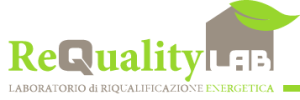Requalification, renovation and saving
Other interventions
Deep Retrofit, Nearly Zero Energy Buildings and Relamping
Big energy savings, zero consumption buildings and energy efficiency for new ways of living.
Deep Retrofit
With Deep Retrofit you get energy savings of more than 50%
What is a Deep Retrofit?
A deep retrofit intervent (or deep energy retrofit) of a building is realized through a process of analysis and renovation that uses an integrated design approach to achieve very substantial energy savings and in any case greater than a standard renovation.
Deep retrofit can be applied to any building, both residential and commercial, of any size, from single-family houses to condominiums, from schools to building for industrial use.
Although the definition varies and is debated internationally, it is currently called deep retrofit an intervention that achieves savings of at least 50% compared to the initial situation.
Thus the deep retrofit of buildings is different from the “renovation” interventions, which normally do not aim to achieve energy savings of the building, and also from the interventions of only “efficiency” that are usually aimed at a single component of the building (for example, the lighting or heating system) and do not grasp the opportunities for really substantial savings.
How to do a Deep Retrofit and what benefits it offers
Deep retrofit achieves substantial efficiency levels because it considers the entire building system and intervenes simultaneously on the different elements that make it up.
It’s based on an accurate energy diagnosis and aimed at comparing the alternative results of different actions (for example, about windows and/or systems, local energy production, building automation and so on).
The benefits of deep retrofit interventions are economic and not economic, direct and indirect, aimed at owners, users and various other stakeholders of the redeveloped real estate.
In summary we have: reduction of energy costs, growth in real estate value for rent and sale of the property, greater attractiveness on the market and occupancy rate of the building; among the non-economic benefits we have the improvement of housing welfare, disease reduction and productivity growth in building for commercial and industrial use.
Nearly Zero Energy Buildings – NZEB
Net-zero energy buildings, a new way to live
Isolate yourself well and produce the necessary energy
For Europe by 2020 all new buildings will be NZEB
In Europe and around the world, scientific research, architectural design and the construction sector are taking the road to the NZEB.
These are buildings that almost completely meet their annual needs with self-produced energy, remaining connected to the electricity network for the management of trade.
To achieve this result, the NZEB produces necessary energy from locally available renewable sources (solar, photovoltaic, wind, geothermal) and at the same time minimizes the overall need, thanks to very efficient insulation and advanced air conditioning and lighting systems.
Even buildings realized in the past, without advanced criteria of energy efficiency, can be improved and converted into a nearly zero energy building (NZEB) thanks to appropriate efficiency interventions.
The impact of the construction sector on climate, the environment and energy has long led Europe to encourage the development of the sector towards more efficient models.
The fundamental principles are indicated in the Energy Performance of Building Directives (EPBD) where one of the key concepts is precisely that of buildings with almost zero consumption, “Nearly Zero Energy Buildings” (NZEB).
For the European Commission, NZEB means a building with high energy performance, that is very low energy demand and in any case produced, in a large percentage, from renewable sources nearby or on-site.
In Europe all Member States must ensure that by 2020 all new buildings are NZEB. In addition, by 2018 all buildings occupied and/or owned by the Public Administration must be NZEB.
Relamping and Energy Efficiency
Il relamping permette importanti recuperi di efficienza con investimenti contenuti
What is Relamping and LED technology
Relamping and energy efficiency
Interior lighting is one of the most interesting areas in the energy upgrading of residential buildings, commercial and tertiary sectors as it allows, thanks to relamping, technically simple and relatively economical interventions that produce high reductions in electricity demand.
Relamping is possible thanks to the progressive diffusion on a large scale of LED technology (Light Emitting Diode), which allows the emission of light following the passage of direct electric current on a thin layer of semiconductor material, phenomenon known as electroluminescence.
This technology, with the necessary precautions to the electrical system to “straighten” the current, making it switch from alternating to continuous, allows to obtain high light yields with a very low energy consumption. To have an order of magnitude, just think that for LEDs the output/consumption ratio (lm/W) is 80-120 lm/W, compared to 10-19 lm/W of incandescent lamps, 12-20 lm/W of halogens and 50-110 lm/W of fluorescents.
This leads to a reduction in electricity consumption, at the same light output, from 37 to 85% resulting in immediate economic savings.
The high efficiency levels of Led Technology must be compared with their initial costs. In these years, there was an evident growth of this new possibility, especially in tertiary and commercial sectors; the request generated the positive reduction of its cost, making it more accessible.
Another positive aspect is about durability. In fact, Led Technology guarantees advantages in terms of maintenance and replacemet costs, if we consider 2.000-5.000 hours of avarage operation of lamps compared to 20.000-60.000 hours of Led.
A Relamping intervention starts with an accurate analysis of the technical aspects of lighting. By considering the economic advantages in according to the installation of Led Technology, the return time of the investment goes from few months to two/three years.
